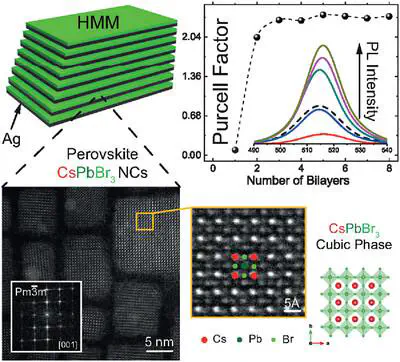Enhanced spontaneous emission through high-k modes in CsPbBr3 perovskite hyperbolic metamaterials

Abstract
Novel optical sources require fast decay rates, making hyperbolic metamaterials (HMMs) an increasingly attractive option. HMMs are well‐known for their remarkable anisotropy, and leverage hyperbolic dispersion to enhance the decay rate of a fluorophore placed on top of them. This study tackles the complex task of embedding a fluorophore into an HMM, successfully overcoming challenges related to surface roughness, thickness imperfections, and layer washing effects. Specifically, CsPbBr3 perovskite nanocrystals (NCs)‐based HMM are fabricated, by alternating silver/nanocrystals (Ag/NCs) layers. Through a systematic investigation of the photophysical response following the deposition of each bilayer, compelling evidence of the achievement of hyperbolic dispersion is provided. Specifically, the impact of ‘high‐k’ modes is isolated, which is distinctive to the HMM architecture. Therefore, the longstanding debate regarding the number of bilayers needed to achieve hyperbolic dispersion is conclusively resolved. The research demonstrates a nearly twofold increase in the decay rate and a threefold enhancement in photoluminescence intensity. These findings are further supported by theoretical Purcell factor calculations. This study marks a pioneering advancement in the field of bulk dye‐embedded HMMs, laying the groundwork for the development of advanced optical sources such as ‘resonant gain HMMs’.